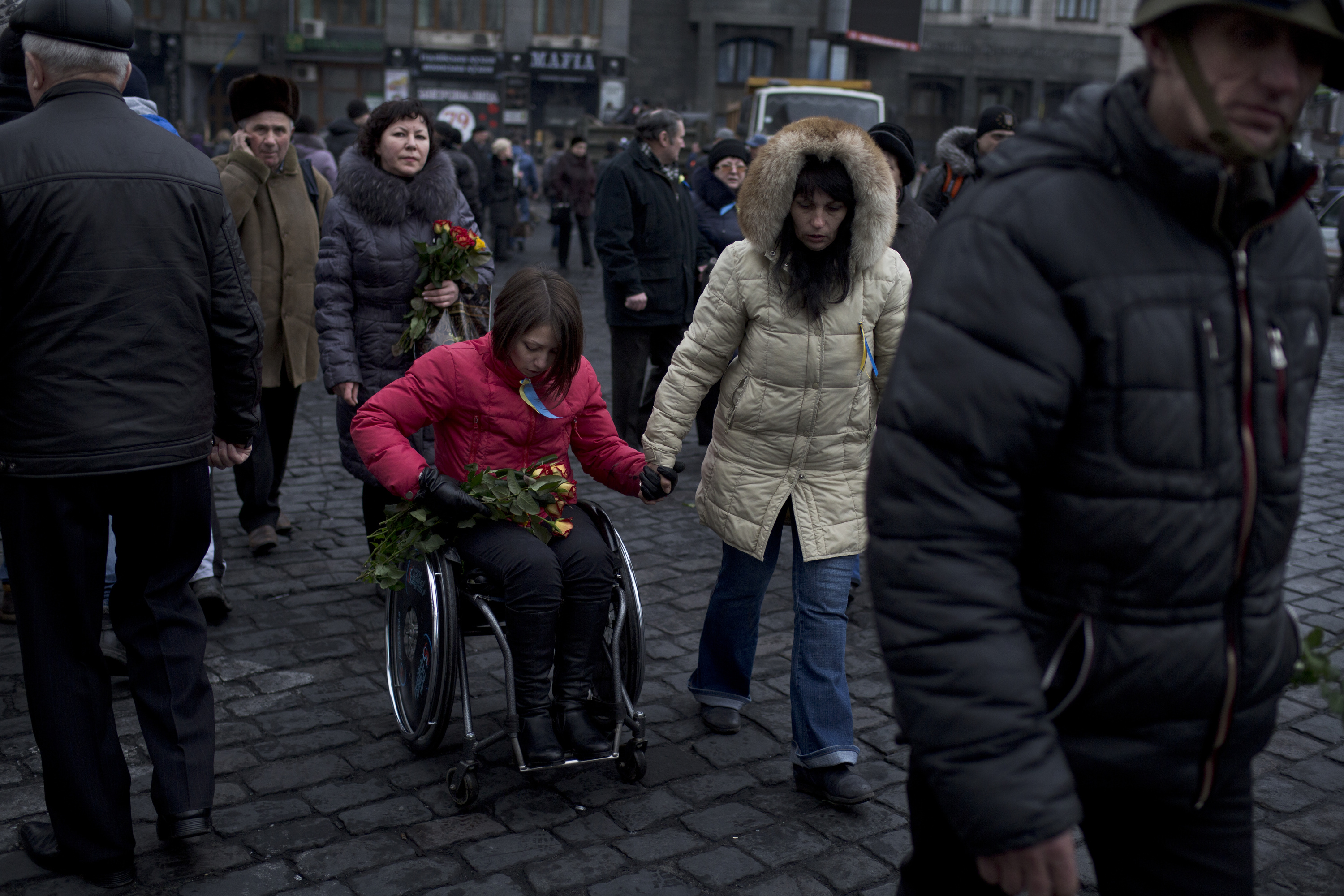
In Kiev, Ukraine, the body of a man killed during clashes between anti-government protesters and the police is carried down Independence Square in a procession on Feb. 21, 2014. After a week that saw dozens killed, opposition and government representatives reached an agreement intended to resolve the crisis. (Ed Ou/Reportage by Getty Images)
As TED Fellows arrive from all over the world to Ed Ou’s hometown of Vancouver for TED2014, Ou himself is far away in Ukraine, where he’s been since February, documenting the civil unrest and growing political tension as a freelance photographer represented by Getty. Today, he writes in to give us an inside view, sending a cache of his work to date, including video segments produced for the New York Times and images from his Instagram feed. Below, Ou answers a few of our questions.
How does the situation in Ukraine feel from where you are?
The situation here is very fluid, and the political stakes are very high. But at the end of the day, the most interesting thing for me is seeing how ordinary people come to terms with extraordinary things happening around them. Many feel empowered, like they now finally have a voice. Others feels like they are at the mercy of politicians in Moscow or Kiev who may or may not represent them. Regardless, everyone has a say about the direction that Crimea — and Ukraine — will go.
Tell us about the videos you’ve produced for the New York Times.
The first video was a look at a short confrontation between the Ukrainian military and the Russian military. When I spoke to the Ukrainian military being slowly pushed out of their posts, trapped in their bases, they told me that any confrontation between Russia and Ukraine is a tragedy because it’s brothers up against brothers. Since this was all part of the Soviet Union, Russians have family in Ukraine, and Ukrainians have family in Russia. The word they would use to describe any war would be “fratricide.”
The second video looks at Crimean Tatars. They are a Muslim minority group who have Turkic roots, and make up 12% of the population here. They have historical reasons to fear Russia. In the 1940s, Stalin deported most of their population to Central Asia on the pretext that they collaborated with the Nazis. Many died along the way — and only in the last few decades did most return. Many are unsure what will happen if Crimea secedes to Russia.
In addition to the still images and videos you make, you also produce an Instagram feed, which was recently featured by National Geographic. How does Instagram fit in with the other work that you do?
The Instagram feed is like a personal diary. It’s my own space where I get to be my own editor and show my own take on what you see in the news. Interestingly, I think the people who are looking at my images on Instagram may be a completely different demographic from people who read newspapers, magazines and so on. So I find that Instagramming photos of international news events — whether it be conflict, political unrest or social issues — can reach people who would otherwise not seek this kind of information out. I’ve had high school students email me asking me to explain the conflict in Gaza that I covered because they followed me on Instagram and saw a photo I posted. I was happy to oblige. Journalism is all about reaching the widest and most diverse audience, and if I can use this medium to inform someone who would otherwise not read a newspaper, then I’m all for it.

A man accused of being a pro-government provocateur is pulled from the crowd as former Prime Minister Yulia Tymoshenko addresses anti-government protesters in Independence Square on February 22, 2014 in Kiev, Ukraine. The leader of the 2004 Orange Revolution against embattled President Viktor Yanukovych, Tymoshenko traveled to Kiev to address the crowd immediately after being released from prison on what many say were politically motivated charges. (Ed Ou/Reportage by Getty Images)

Anti-government protesters have a makeshift meeting in a bus stop atop Independence Square on Feb. 24, 2014. (Ed Ou/Reportage by Getty Images)

Women distribute flowers to anti-government protesters guarding the barricades in Independence Square on Feb. 23, 2014. (Ed Ou/Reportage by Getty Images)

Anti-government protesters stand near barricades and tents during a sit-in on Feb. 24, 2014. (Ed Ou/Reportage by Getty Images)
Note: This post originally ran on the TED Fellows blog. Read much more about the TED Fellows program and what this incredible group of young trailblazers is doing at TED2014 »
Comments (5)
Pingback: In the Skype Studio: How social media transforms ideas and movements | BizBox B2B Social Site
Pingback: In the Skype Studio: How social media transforms ideas and movements - Rixal Communications | Custom Media & Advertising | Media. Solved. | Rixal.com
Pingback: Team Vista's Integrated and Powerful Learning/Reading & Writing Workshop - Today in SSEnglish, Wednesday, May 7, 2014